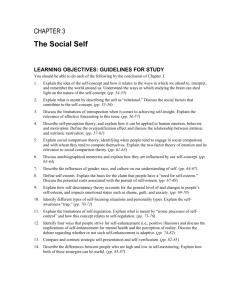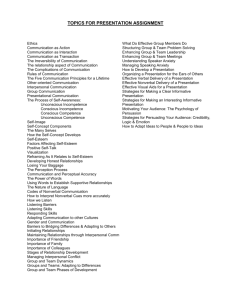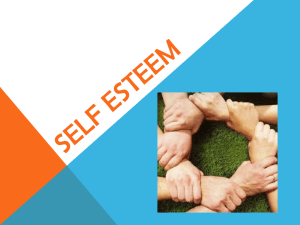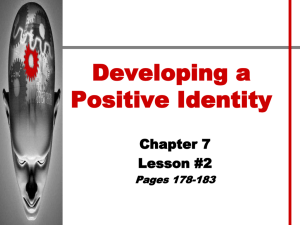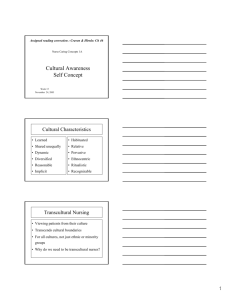Self - Lycoming College
advertisement
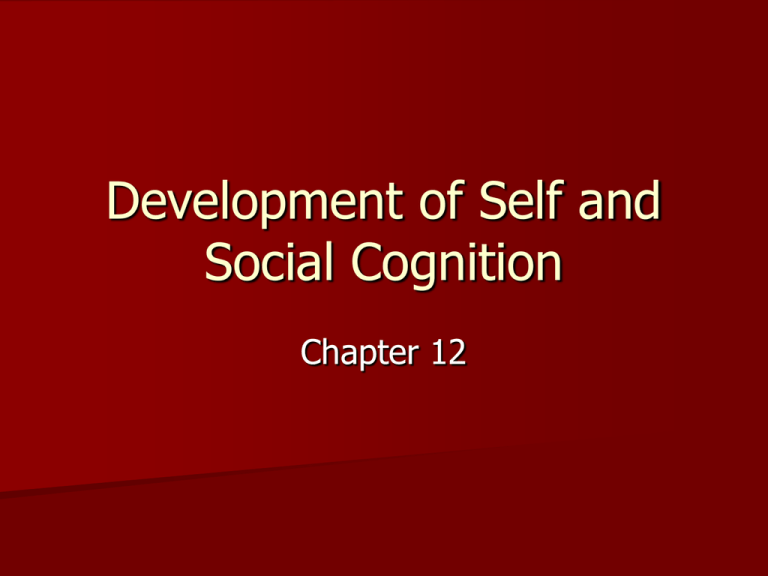
Development of Self and Social Cognition Chapter 12 Social Cognition Parallels Between Social and Nonsocial Cognition (Flavell) – surface appearances underlying realities – salient characteristics Differences in Social and Nonsocial Cognition – Which is easier? – Physical forces… What develops faster…social or nonsocial cognition? Knowledge of Self Develops in social context Separate and different before understanding self Two aspects of self – The knower (“I”)/self as subject – Perceived self/object (“Me”)/categorical self Self-recognition – Visual recognition task 18 months Knowledge of Self Lewis & Brooks-Gunn – Photographs of self and other children – Live videotape of self – Prerecorded videotape of self – Videotape of another child Knowledge of Self Lewis & Brooks-Gunn Results: – By 9 months, contingency cues – Later featural cues – By 2 years, contingent and noncontingent situations Knowledge of Self Lewis & Brooks-Gunn (1979) believe that “it is the ability to recognize and respond to [the] self independent of contingency which represents the important developmental milestone in selfrecognition” (p. 218). Self-Concept A summary of personal characteristics (abilities, attitudes, attributes, values) that an individual believes defines who s/he is Preschoolers concrete characteristics Between 8-11 shift to psychological qualities Adolescence qualify characteristics; also emphasize social virtues Self-Concept 9 y/o: My name is Bruce. I have brown eyes. I have brown hair. I love sports. I have seven people in my family. I have great eyesight. I have lots of friends…I have an uncle who is almost 7 feet tall. Self-Concept 11 ½ y/o: My name is A. I’m a human being…a girl…a truthful person. I’m not pretty. I do so-so in my studies. I’m a very good cellist. I’m a little tall for my age. I like several boys…I’m old fashioned. I am a very good swimmer…I try to be helpful…Mostly I’m good, but I lose my temper. I’m not well liked by some girls and boys. I don’t know if boys like me… Self-Concept 17 y/o: I am a human being…a girl…an individual…I am a Pisces. I am a moody person…an indecisive person…an ambitious person. I am a big curious person…I am lonely. I am an American (God help me). I am a Democrat. I am a liberal person. I am a radical. I am conservative. I am pseudoliberal. I am an Atheist. I am not a classifiable person (that is, I don’t want to be). Self-Concept Montemayor & Eisen adolescents incorporate many types of descriptors; more complex Are young children unaware of their psychological characteristics or do they simply not have the appropriate vocabulary? Self-Concept If children are unaware, is it because they’re cognitively incapable of grasping these abstract qualities or is it because adults tend not to actively reflect back their impressions of children in these terms? Self-Concept Effect of number of answers requested? Eder (1990) used a forced-choice recognition task – 180 children, ages 3 ½ to 7 – Presented with 50 pairs of statements: “I mostly do things that are hard.” vs. “I mostly do things that are easy.” (Achievement) “When I get angry, I feel like hitting someone.” vs. “When I get angry, I feel like being quiet.” (Aggression) Self-Concept Eder (1990) con’t – Responses were internally consistent at every age – Self-conceptions were moderately stable over 1 month • Figure 12.2 Average number of inconsistent attributes reported by 13-, 15-, and 17-yearolds (panel A) and the percentages of 13-, 15-, and 17-year-olds who said they were confused or “mixed up” by these inconsistencies in their self-portraits (panel B). ADAPTED FROM HARTER & MONSOUR, 1992. • Figure 12.3 Average percentages of personal/individualistic and social/relational attributes listed as core dimensions of the self-concept by American and Japanese students who responded to a “Who Am I?” questionnaire. ADAPTED FROM COUSINS, 1989. Attributions and Self-Concept Grusec & Redler – 7-8 y/o played bowling game – Scored points = won marbles – Marbles could be exchanged for toys – More marbles = better toys – Could donate marble to charity Attributions and Self-Concept Conditions – attribution: “I guess you’re the kind of person who likes to help others whenever you can. Yes, you are a very nice and helpful person” – reinforcement: “It was good that you gave some marbles to those poor children. Yes, that was a nice and helpful thing to do” – control: no statement Attributions and Self-Concept Results – marble donation: attribution & reinforcement donated more than control – pencils: attribution more than others, no difference between reinforcement and control – cards: same as pencils – drawings & craft materials: same Self-Esteem Judgments we make about our own worth as well as the feelings that are associated with those judgments Combination of separate self-evaluations into a general appraisal of ourselves “A person with high self-esteem is fundamentally satisfied with the type of person he is, yet he may acknowledge his faults while hoping to overcome them” (Rosenberg, 1979, p. 31). Self-Esteem Once believed that self-esteem/worth wasn’t apparent until school-age Recent research suggests that preschool children display self-esteem/worth behaviorally – High self-worth = confidence, curiosity, initiative, independence, can tolerate change/stress – Low self-worth = low confidence, low curiosity, low initiative, low independence, difficulty reacting to change/stress Models of Self-Esteem James – weighting of competencies – Self-esteem = competencies/”pretensions” Cooley – “Looking glass self” – Others are the social mirror into which one gazes for information that defines the self Who is correct? Self-Esteem Harter measured perceptions of competence and then asked children how important success in each domain was A discrepancy score (competence minus importance) was averaged across domains child considered important Bigger discrepancy score in negative direction lower self-esteem should be Self-Esteem High self-esteem/worth should be associated with scores close to zero, indicating that one’s perceived competence is similar to importance Correlations between competence/importance discrepancy scores and self-worth ranged from -.72 to -.55 across children between 8-15 Self-Esteem Others’ opinions toward self = degree to which children felt that others acknowledged their worth as a person Items addressed extent to which children felt others treated them like a person who matters, felt they were important, listened to what they had to say… Correlations between overall positive regard and self-worth ranged from .50 to .56 Influences on Self-Esteem Culture – Social comparison plays strong role in American culture – Collectivist culture emphasizes humility and self-effacement; derive self-worth from contributing to the welfare of the groups to which they belong Influences on Self-Esteem Child-Rearing Practices – Warm, responsive parenting, reasonable expectations for behavior higher selfesteem – Highly coercive parenting, communication of inadequacy lower self-esteem – Overly tolerant, indulgent parenting false sense of high self-esteem Influences on Self-Esteem Peers – use of social comparison as early as 4-5 – adolescence Components of Self-Esteem Before age 7, children distinguish how well others like them (social acceptance) from how “good” they are at doing things (competence) Above 7-8, self-esteems = academic, physical, social Inaccurately high self-perceptions of competence – Based on wishes/desires Illusion of Incompetence Hold low expectations for success, evidence less persistence, more feelings of anxiety, feel that important adults hold equally low perceptions of their abilities Mothers/fathers of highly competent children with low perceived competence have lower perceptions of their children’s abilities; do not have equally low expectations for achievement Components of Self-Esteem Adolescence interpersonal relationships Relational self-worth = feelings of selfesteem within a particular relationship context Changes in Self-Esteem Decline into middle and high school Multiple stressors contribute Overall stability lowest in childhood and early adolescence Relatively stable in late adolescence and early adulthood Gender Differences in Self-Esteem emerge by early adolescence girls lower self-esteem Identity firm and coherent sense of who one is, where one is heading, and where one fits into society Identity Marcia – Identity diffusion – Foreclosure – Moratorium – Identity achievement • Figure 12.8 Percentages of participants in each of Marcia’s four identity statuses as a function of age. Note that resolution of the identity crisis occurs much later than Erickson assumed: Only 4 percent of the 15-year-olds and 20 percent of the 18-year-olds had achieved a stable identity. FROM MEILMAN, 1979. Marie is a 14-year-old who, when asked what she wants to do when she graduates from high school, replies, “Maybe I will get married and have some children, or maybe I will be a neurosurgeon, or a fashion designer. I’m going to take anatomy and physiology next year to see if I’d like to be a physician and I’m taking home economics to see if I enjoy designing clothes and working at home.” Seventeen-year-old Suzanne is questioning the tenets of the religion in which she was brought up. For the first time, she is examining her beliefs and considering other belief systems. At the end of the period, she chooses to follow the same religion as her parents. Lorraine is 16 years old and, when asked what she wants to do when she graduates from high school, replies, “I never really thought about it. I guess I will decide when the time comes.” After Bill graduates from high school, he plans to go into his father’s business. He has been talking this over with his parents since he was a young boy and is eager to fulfill his parents’ expectations. Michael was asked to debate issues concerning premarital sex in his health class. His parents always taught him that premarital sex was wrong and that they would be disappointed if they discovered he had participated. After thoroughly investigating the consequences of premarital sex, Michael came out against it. Influences on Identity Formation Cognitive Influences – formal-operational thought helps imaging and contemplate future identities Parenting Influences – Being neglected/rejected – Too controlling – Affection, mutual respect Scholastic Influences Social-Cultural Influences Knowledge of Other Children < 8 Procedure involves asking children to give oral or written responses to instructions such as: “I want you to describe what sort of person Sally is…” Studies using this methodology find that the use of dispositional attributions increases with age Knowledge of Other Heller & Berndt – Kindergarten, third, and sixth grade children, plus college students – Information about an actor: “generous actor” = actor shared part of his/her lunch with other children “selfish actor” = refused to share lunch Control = given information about age/sex of child, but told nothing about behavior Knowledge of Other Heller & Berndt (con’t) – Asked to rate actor on 10 traits: share, selfish, help, nice, naughty, lie, tease, smart, and two fillers – Children’s responses were similar to each other and to college students’ responses Holly is an 8-year-old girl who likes to climb trees. She is the best tree climber in the neighborhood. One day while climbing down from a tall tree, she falls…but does not hurt herself. Her father sees her fall. He is upset and asks her to promise not to climb trees any more. Holly promises. Later that day, Holly and her friends meet Shawn. Shawn’s kitten is caught in a tree and can’t get down. Something has to be done right away or the kitten may fall. Holly is the only one who climbs trees well enough to reach the kitten and get it down but she remembers her promise to her father. Knowledge of Others Role-taking and thinking about relationships – Preschool – any positive interaction equals a friendship – 6-8 years – common activities and one-way friendships – 8-10 – reciprocal friendships – Adolescence – exchange of intimate thoughts or feelings
